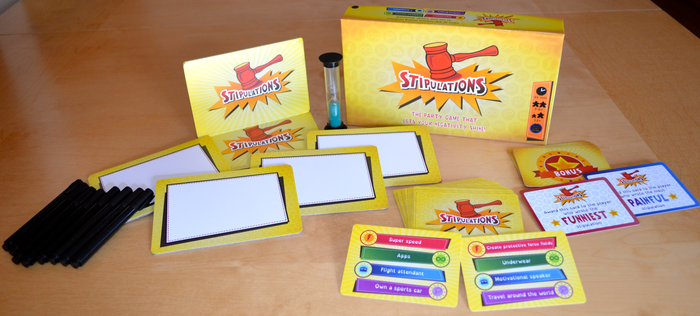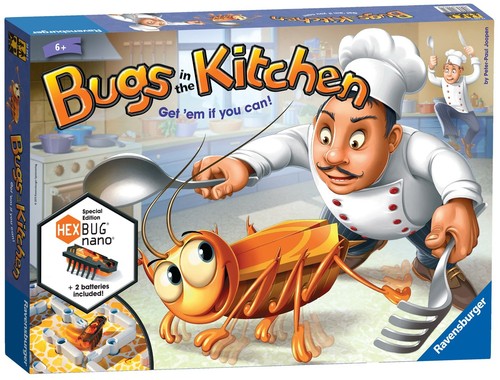Red7 – Win each turn or you’re out!
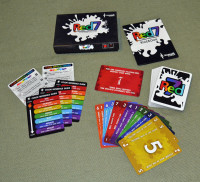
February is a short month. So why not start off the month looking at a short, simple, and very colorful card game – Red7.
Red7 was released in 2014 by Asmadi Games and caught my attention because of its very unique game condition: You have to be winning at the end of your turn or you’re out of the game.
It’s that simple. If you can’t meet the current win condition, then you’re out.
Now, of course, getting knocked out of a card game may not sound like much fun. But with how quickly the game plays, you won’t be out for long before you’re playing again.
Many people don’t like player-elimination games.
However, Red7 is a card game that’s played in rounds. So just because you’re knocked out in a round, doesn’t mean you should abandon all hope.
You’ll quickly be back in the game battling for the next round win and ultimate victory.
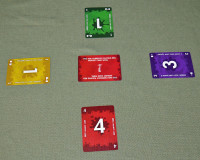
How to play Red7
Red7 is a very simple game to play for 2 to 4 players.
The deck is made up of 49 cards numbered 1-7 each in 7 different colors.
Since it’s a colorful game, the cards played in front of a player are called his/her “Palette” and the cards in the center stack that determine the win condition is referred to as the “Canvas”.
To begin the game, each player is dealt 7 cards for their hand. Then one card from the remaining deck is flipped over in front of each player. The first win condition card of the game is also placed in the center of the table to begin the Canvas pile – “Highest Card Wins”.
Since the beginning Canvas card (win condition) is always “highest card wins”, the player with the highest card in their Palette is currently winning.
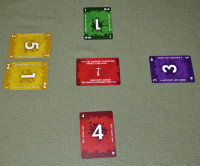
So the first person to take a turn will be the player to the left of that ‘winning’ player.
That player can do 1 of 4 things on their turn.
- Play one card face up to their Palette.
- Play one card face up to the Canvas.
- Play one card to their Palette AND one card to the Canvas.
- Do nothing and be knocked out of the round.
Obviously, players will choose one of the options that will make them the new ‘winning’ player or they’ll have to do #4 and be out.
In each of the first 3 options, the conditions in the game will change. Either the player will add a card to their Palette that will set them up to be winning. Or they will change the win condition card on the Canvas pile. Or they’ll have to both change the win condition card AND place a card to their Palette so that they’re currently winning.
Once that player is winning, play continues to the player to the left.
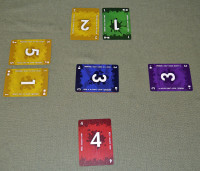
See how simple that is?
There’s only on major catch – you don’t draw more cards during the round!
You’ll play a card (or two) every turn without drawing back into your hand. And that’s why rounds play so quickly. After a few turns each, the round is over.
With only you’re starting 7 cards to work with, determining which cards to play where and when will make a big difference on the outcome.
So it can get a bit tricky.
Follow the flow of photos to the right to see sample progress through a round.
Note: There are Advanced rules that allow for drawing more cards (explained below).
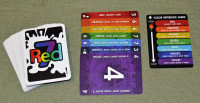
The different winning conditions
Since each turn comes down to whether you’re winning or not, let’s take a look at what it takes to be “winning”.
Each color in the game has a different winning condition. (When cards are played to the Canvas in the center, the number on the card doesn’t matter, just the color.)
- Highest value card (Red)
- Most cards of one number (Orange)
- Most cards of one color (Yellow)
- Most even numbered cards (Green)
- Most cards of different colors (Blue)
- Most cards that form a run (Indigo)
- Most cards below 4 (Violet)
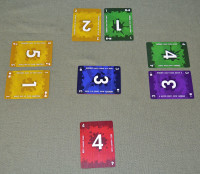
As mentioned, the game starts out with the Red win condition. So the player with the highest number of any of the cards on the table will be winning. The highest number available is “7”.
Players are “winning” the round if their Palette contains more cards that meet the Canvas win conditions than any other player (ignoring the cards that don’t meet the condition). If there is ever a tie, whoever has the highest card value of those meeting the win condition.
For example, if the win condition (like in the photo to the right) is “most cards that form a run” two players have a run of 2 cards. One player has a 1 and a 2 in their Palette and another player has a 3 and a 4. Since both runs are just 2 cards, the player with the highest card in their run (in this case a 4) is currently winning.
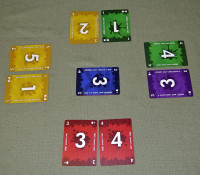
If the card values are tied, then the tie is broken based on the color of that card following the color hierarchy. The reference cards included in the game (and pictured above) indicate the color order for breaking ties. For example, a yellow 5 will beat a blue 5.
Advanced Rules
Once you’ve played Red7 a few times, we’re sure you’ll want to start playing the Advanced Rules. The main reason is because you’ll get to draw more cards to your hand.
Advanced Rule #1 – Draw Cards: When a player plays a card to the Canvas, if the number on that card is higher than the total number of cards in their Palette, they may draw a card from the deck to add to their hand.
This is a great way to play because you’ll have more options to continue playing and less likely to be knocked out. However, don’t get too excited because you still won’t draw a ton of new cards to your hand. Because the number has to be higher than the quantity of cards in your Palette, the likelihood of drawing more cards diminishes as you get further along and have more cards in your Palette.
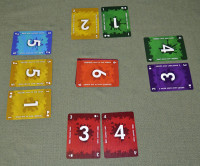
That being said, it’s still a great rule to include in your games.
Advanced Rule #2 – Score Between Rounds: The winner of each round takes all the cards in their Palette that meets the current win conditions and places them face down in their score pile (or like the rules state, hidden under their reference card). Cards in the score pile are worth their face value in points.
Cards for the next round are dealt out without those cards. Play continues until one player reaches the number of points to win (the target number of points depends on number of players).
Another way for the game to end is by not having enough cards to deal out a full hand to begin a new round. At that point the game will end and the person with the most points wins.
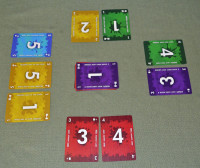
Optional Rules
In addition to the Advanced Rules, Red7 also includes a few more twists you can include in the game.
Every Odd numbered card has an icon in the corner. When a player plays one of these cards to their Palette, they MUST perform that action.
The actions are:
- #1 card – Take a card from another player’s Palette and place it face down on top of the draw deck.
- #3 card – Draw a card from the draw deck.
- #5 card – Play another card from your hand to your Palette.
- #7 card – Play one other card from your Palette to the Canvas (you must still be winning that newly played win condition).
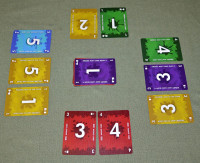
Strategy vs. Luck
Regular readers of our reviews know that we love a good balance of luck and strategy in our family games.
As you may have surmised from our review, Red7 leans further towards the Luck side of the equation.
We don’t mind luck in simple and quick card games because they’re just that – simple and quick. They’re meant for light play to be enjoyed in a casual setting.
However, that also doesn’t mean Red7 is devoid of strategy.
Yes, players are limited by what cards they’re dealt at the beginning of a round. But how and when you play your cards will definitely affect the outcome.
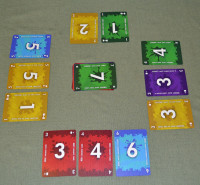
Playing the Advanced as well as the Optional Rules adds in more strategic elements. We like scoring between and playing multiple rounds because the amount of luck will be mitigated a bit over multiple rounds. Using these elements strikes a good balance for this light card game.
Can the whole family enjoy Red7?
Red7 can be enjoyed by everyone in the family that understands numbers and colors. Which of course means that plenty of people can enjoy Red7.
The choices on each turn are pretty straight forward, but still require some thought.
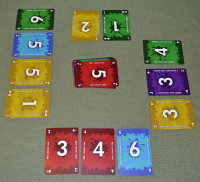
It’s fun to see kids think through their options to win every turn.
Plus, kids love to be “winning”.
So when they’re told after every one of their turns that they’re “winning”, then they get that triumphant smile on their faces numerous times throughout the game rather than just waiting until the end.
Everyone gets to be a winner! (at least temporarily)
How does Red7 score on our “Let’s Play Again” game meter?
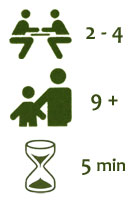 Red7 scores very well on our “let’s play again” game meter. As you can tell, each round of Red7 doesn’t last very long. But also a full game made up of several rounds doesn’t last overly long either. It’s such a simple game to play that it’s easy to “play one more time.”
Red7 scores very well on our “let’s play again” game meter. As you can tell, each round of Red7 doesn’t last very long. But also a full game made up of several rounds doesn’t last overly long either. It’s such a simple game to play that it’s easy to “play one more time.”
It’s also such a small card game that it’s easy to take along wherever you go and easily pull out and play.
It’s going to be a staple to throw in our game bag when we head out.
And at only $12 – it’s a definite buy. Go snag a copy for your family.
Thanks Asmadi Games for this light, fun card game!
| The Board Game Family Game Ratings | |
| Caleb | |
| Brooke | |
| Jaden | |
| Trevor | |
| Mom | |
| Dad | |
| Average | |
Other light, family card games you may also enjoy:

